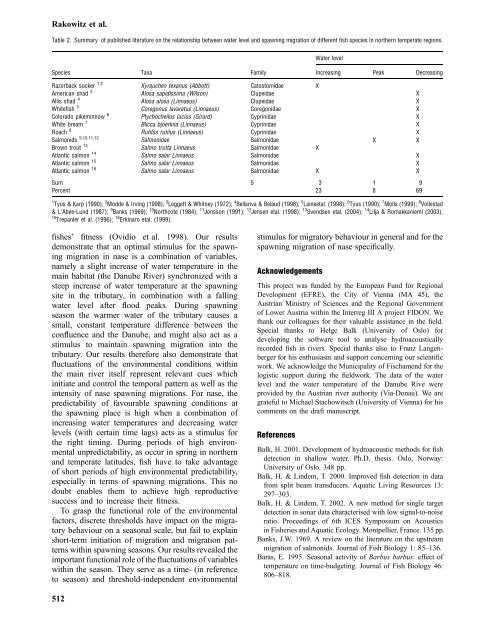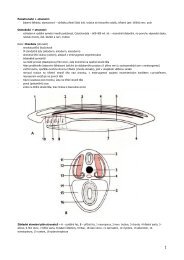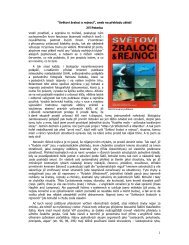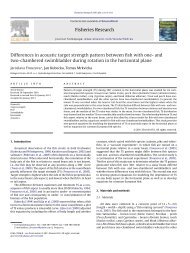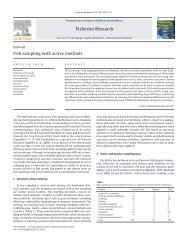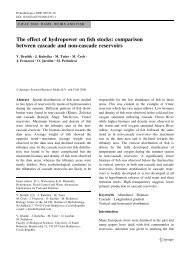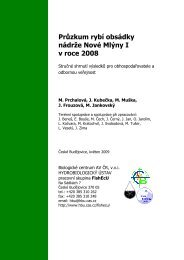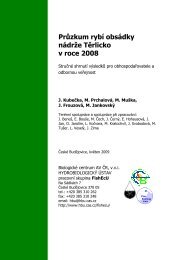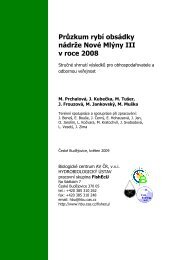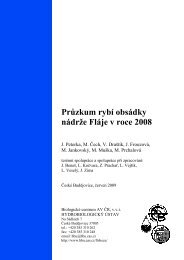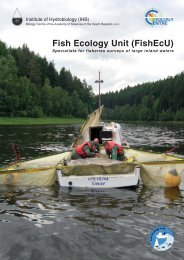Chondrostoma nasus - Biology Centre of the Academy of Sciences of
Chondrostoma nasus - Biology Centre of the Academy of Sciences of
Chondrostoma nasus - Biology Centre of the Academy of Sciences of
Create successful ePaper yourself
Turn your PDF publications into a flip-book with our unique Google optimized e-Paper software.
Rakowitz et al.<br />
Table 2. Summary <strong>of</strong> published literature on <strong>the</strong> relationship between water level and spawning migration <strong>of</strong> different fish species in nor<strong>the</strong>rn temperate regions.<br />
Species Taxa Family<br />
fishes’ fitness (Ovidio et al. 1998). Our results<br />
demonstrate that an optimal stimulus for <strong>the</strong> spawning<br />
migration in nase is a combination <strong>of</strong> variables,<br />
namely a slight increase <strong>of</strong> water temperature in <strong>the</strong><br />
main habitat (<strong>the</strong> Danube River) synchronized with a<br />
steep increase <strong>of</strong> water temperature at <strong>the</strong> spawning<br />
site in <strong>the</strong> tributary, in combination with a falling<br />
water level after flood peaks. During spawning<br />
season <strong>the</strong> warmer water <strong>of</strong> <strong>the</strong> tributary causes a<br />
small, constant temperature difference between <strong>the</strong><br />
confluence and <strong>the</strong> Danube, and might also act as a<br />
stimulus to maintain spawning migration into <strong>the</strong><br />
tributary. Our results <strong>the</strong>refore also demonstrate that<br />
fluctuations <strong>of</strong> <strong>the</strong> environmental conditions within<br />
<strong>the</strong> main river itself represent relevant cues which<br />
initiate and control <strong>the</strong> temporal pattern as well as <strong>the</strong><br />
intensity <strong>of</strong> nase spawning migrations. For nase, <strong>the</strong><br />
predictability <strong>of</strong> favourable spawning conditions at<br />
<strong>the</strong> spawning place is high when a combination <strong>of</strong><br />
increasing water temperatures and decreasing water<br />
levels (with certain time lags) acts as a stimulus for<br />
<strong>the</strong> right timing. During periods <strong>of</strong> high environmental<br />
unpredictability, as occur in spring in nor<strong>the</strong>rn<br />
and temperate latitudes, fish have to take advantage<br />
<strong>of</strong> short periods <strong>of</strong> high environmental predictability,<br />
especially in terms <strong>of</strong> spawning migrations. This no<br />
doubt enables <strong>the</strong>m to achieve high reproductive<br />
success and to increase <strong>the</strong>ir fitness.<br />
To grasp <strong>the</strong> functional role <strong>of</strong> <strong>the</strong> environmental<br />
factors, discrete thresholds have impact on <strong>the</strong> migratory<br />
behaviour on a seasonal scale, but fail to explain<br />
short-term initiation <strong>of</strong> migration and migration patterns<br />
within spawning seasons. Our results revealed <strong>the</strong><br />
important functional role <strong>of</strong> <strong>the</strong> fluctuations <strong>of</strong> variables<br />
within <strong>the</strong> season. They serve as a time- (in reference<br />
to season) and threshold-independent environmental<br />
stimulus for migratory behaviour in general and for <strong>the</strong><br />
spawning migration <strong>of</strong> nase specifically.<br />
Acknowledgements<br />
This project was funded by <strong>the</strong> European Fund for Regional<br />
Development (EFRE), <strong>the</strong> City <strong>of</strong> Vienna (MA 45), <strong>the</strong><br />
Austrian Ministry <strong>of</strong> <strong>Sciences</strong> and <strong>the</strong> Regional Government<br />
<strong>of</strong> Lower Austria within <strong>the</strong> Interreg III A project FIDON. We<br />
thank our colleagues for <strong>the</strong>ir valuable assistance in <strong>the</strong> field.<br />
Special thanks to Helge Balk (University <strong>of</strong> Oslo) for<br />
developing <strong>the</strong> s<strong>of</strong>tware tool to analyse hydroacoustically<br />
recorded fish in rivers. Special thanks also to Franz Langenberger<br />
for his enthusiasm and support concerning our scientific<br />
work. We acknowledge <strong>the</strong> Municipality <strong>of</strong> Fischamend for <strong>the</strong><br />
logistic support during <strong>the</strong> fieldwork. The data <strong>of</strong> <strong>the</strong> water<br />
level and <strong>the</strong> water temperature <strong>of</strong> <strong>the</strong> Danube Rive were<br />
provided by <strong>the</strong> Austrian river authority (Via-Donau). We are<br />
grateful to Michael Stachowitsch (University <strong>of</strong> Vienna) for his<br />
comments on <strong>the</strong> draft manuscript.<br />
References<br />
Water level<br />
Increasing Peak Decreasing<br />
Razorback sucker 1,2<br />
Xyrauchen texanus (Abbott) Catostomidae X<br />
American shad 3<br />
Alosa sapidissima (Wilson) Clupeidae X<br />
Allis shad 4<br />
Alosa alosa (Linnaeus) Clupeidae X<br />
Whitefish 5<br />
Coregonus lavaretus (Linnaeus) Coregonidae X<br />
Colorado pikeminnow 6<br />
Ptychocheilus lucius (Girard) Cyprinidae X<br />
White bream 7<br />
Blicca bjoerkna (Linnaeus) Cyprinidae X<br />
Roach 8<br />
Rutilus rutilus (Linnaeus) Cyprinidae X<br />
Salmonids 9,10,11,12<br />
Salmonidae Salmonidae X X<br />
Brown trout 13<br />
Salmo trutta Linnaeus Salmonidae X<br />
Atlantic salmon 14<br />
Salmo salar Linnaeus Salmonidae X<br />
Atlantic salmon 15<br />
Salmo salar Linnaeus Salmonidae X<br />
Atlantic salmon 16<br />
Salmo salar Linnaeus Salmonidae X X<br />
Sum 5 3 1 9<br />
Percent 23 8 69<br />
1 Tyus & Karp (1990); 2 Modde & Irving (1998); 3 Leggett & Whitney (1972); 4 Bellariva & Belaud (1998); 5 Laineetal. (1998); 6 Tyus (1990); 7 Molls (1999); 8 Vollestad<br />
& L’Abee-Lund (1987); 9 Banks (1969); 10 Northcote (1984); 11 Jonsson (1991); 12 Jensen etal. (1998); 13 Svendsen etal. (2004); 14 Lilja & Romakkaniemi (2003);<br />
15 Trepanier et al. (1996); 16 Erkinaro etal. (1999).<br />
512<br />
Balk, H. 2001. Development <strong>of</strong> hydroacoustic methods for fish<br />
detection in shallow water. Ph.D. <strong>the</strong>sis. Oslo, Norway:<br />
University <strong>of</strong> Oslo. 348 pp.<br />
Balk, H. & Lindem, T. 2000. Improved fish detection in data<br />
from split beam transducers. Aquatic Living Resources 13:<br />
297–303.<br />
Balk, H. & Lindem, T. 2002. A new method for single target<br />
detection in sonar data characterised with low signal-to-noise<br />
ratio. Proceedings <strong>of</strong> 6th ICES Symposium on Acoustics<br />
in Fisheries and Aquatic Ecology. Montpellier, France. 135 pp.<br />
Banks, J.W. 1969. A review on <strong>the</strong> literature on <strong>the</strong> upstream<br />
migration <strong>of</strong> salmonids. Journal <strong>of</strong> Fish <strong>Biology</strong> 1: 85–136.<br />
Baras, E. 1995. Seasonal activity <strong>of</strong> Barbus barbus: effect <strong>of</strong><br />
temperature on time-budgeting. Journal <strong>of</strong> Fish <strong>Biology</strong> 46:<br />
806–818.


